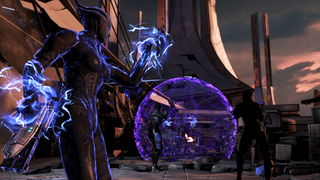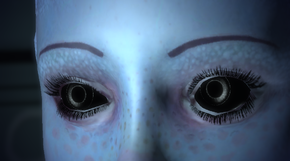Asari
The asari, native to the planet Thessia, are often considered the most influential and respected sentient species in the galaxy, and are known for their elegance, diplomacy, and biotic aptitude. This is partly due to the fact that the asari were among the earliest races to achieve interstellar flight after the Protheans, and the first to discover and settle the Citadel.
A mono-gender race, the asari are distinctly feminine in appearance and possess maternal instincts. Their unique physiology, expressed in a millennium-long lifespan and the ability to reproduce with a partner of any gender or species, gives them a conservative yet convivial attitude toward other races. Favoring compromise and cooperation over conflict, the asari were instrumental in proposing and founding the Citadel Council and have been at the heart of galactic society ever since.
Basic Information
Anatomy
Asari resemble humans in terms of basic skeletal structure with five digits on each hand and feet that are relatively straight (certainly in comparison to species like quarians and turians). This similarity allows asari to wear human armor. A typical asari has a blue to purple complexion, though a teal complexion is possible albeit seemingly rare. Some asari, such as Matriarch Lidanya, Matriarch Benezia, Liara T'Soni, and Tela Vasir have facial markings, which are unique colored patterns that vary for every asari. Some of these facial markings resemble the eyebrows that humans have, but the asari do not think of the markings as such themselves. In the place of head hair, asari possess semi-flexible, cartilage-based scalp-crests that grow into shape. These structures are rigid, and do not "flop around" as some believe. Asari have navels as well as breasts that continue to grow with age. Asari also have a robust cellular regenerative system; while they do not heal faster than other species, they are known to reach over 1000 years of age. This long lifespan is rivaled only by the krogan. Asari can see ultraviolet at the short-wavelength end of the spectrum. Asari blood is purple.
There is some conflicting information regarding the gender of the asari. Asari are a mono-gendered species with no concept of gender differences. According to Liara, "male and female have no real meaning for us," and, if asked, says that she is "not precisely a woman." At the same time, asari are often viewed as an all-female race, including by the Codex and by the Galactic Codex: Essentials Edition 2183. To humans at least, asari appear female with breasts and voices that sound female. Even among the asari, many individual asari are referred to as “she” and “her“ but some asari prefer male pronouns, while others gravitate toward gender-neutral where language allows. Asari also bear feminine titles like “huntress” and “matriarch” and asari offspring are referred to as “daughters“, however the asari may have chosen feminine pronouns to simplify language translations.
Genetics and Reproduction
However asari gender is defined, they are innately different from humans, for asari can mate and successfully reproduce with any other gender or species through a form of parthenogenesis. Although they have one gender, they are not asexual and do in fact require a partner to reproduce.
However, asari reproduction is very different from other forms of sexual reproduction. An asari provides two copies of her own genes to her offspring, one of which is passed on unaltered. The second set of genes is altered in a unique process called melding, also known as the joining or the union. During melding, the eyes of the asari initiating the meld dilate as she consciously attunes her nervous system to her partner's, sending and receiving electrical impulses directly through the skin, however physical contact is not strictly necessary. A common phrase used before melding is "embrace eternity," presumably to help focus the partner's mind. Effectively, the asari and her partner briefly become one unified nervous system, sharing memories, thoughts, and feelings. The offspring is always an asari, regardless of the species or sex of the "father" and in the case that the offspring is of two asari, the father is the one who does not give birth.
Uniquely, the asari are known to be perceived as attractive to many other species. This may be because of shared physical characteristics (e.g., body shape for humans, skin color for salarians, head fringe for turians). Mordin Solus postulates that the mechanism behind the asari's cross-species attraction may be neurochemical in nature. The offspring resulting from such interspecies pairings are always asari as no DNA is taken from the partner. Instead, the asari uses the meld to explore her partner's genetic heritage and pass desirable traits on to any offspring and as a "map" to randomize the genes of the offspring. Additionally, pairings with krogan are not affected by the Genophage. As such, pairings with asari are sometimes seen as a way for a krogan to circumvent the Genophage and have children of their own.
The drawback to the asari means of reproduction are the Ardat-Yakshi. These individuals possess a rare genetic defect that causes an asari to overwhelm and destroy her partner’s nervous system when joining. The condition seems to appear only amongst pureblood asari, those whose parents are both asari.
It is also possible for an asari to meld with another for the sole purpose of transferring thoughts, without reproduction. The asari initiating the meld can both send and receive information. Liara melds with Commander Shepard several times for the purpose of viewing and helping understand the visions Shepard received from the Prothean beacon. Shiala later melds minds with Shepard for the purpose of “uploading” the Cipher into Shepard’s mind in order to help the Commander understand the visions. Liara also states that the melding of minds is a sign of a deep connection between two individuals, something often reserved for friends and family members; it is also a way to say “farewell.”
Growth Rate & Stages
Asari pass through three climacteric life stages, marked by biochemical and physiological changes:
The Maiden stage begins at puberty and is marked by the drive to explore and experience. Most young asari are curious and restless, and it is not uncommon for many to try their hand at dancing in bars or working as mercenaries during this time.
The Matron stage of life begins around the age of 350, though it can be triggered earlier if the individual melds frequently. This period is marked by a desire to settle in one area and raise children.
The Matriarch stage begins around 700 years of age, or earlier if the individual melds rarely. Matriarchs become active in their community as sages and councilors, dispensing wisdom from centuries of experience. Their knowledge and guidance may be one reason why Matriarchs are rarely seen outside asari space.
However, it should be noted that each stage can be started whenever an asari feels that she has reached the correct level of maturity. While each stage of life is marked by strong biological tendencies, individuals do make unexpected life choices. For example, there are Maidens who stay close to home rather than explore, Matrons who would rather work than build a family, and Matriarchs who have no interest in community affairs.
Additional Information
Social Structure
Because of their long lifespan, asari tend to have a "long view" not common in other races. When they encounter a new species or situation, the asari are more comfortable with an extended period of passive observation and study than immediate action. They are unfazed that some of their investments or decisions may not pay off for decades or centuries. Matriarchs can seem to make incomprehensible decisions, but their insight is evident when their carefully-laid plans come to fruition. In interstellar relations, this long view manifests in the unspoken policy of centrism. The asari instinctively seek to maintain stable balances of economic, political, and military power.
Traditionally, asari spread their influence through cultural domination and intellectual superiority. They invite new species of advanced development to join the galactic community, knowing that their ideals and beliefs will inevitably influence the existing culture. The asari tend toward communal, consensus attitudes among themselves too: for example, they prefer to live in shared spaces aboard starships even if there are alternatives available.
Asari believe that their offspring acquire the best qualities of the "father" from the melded genes, but evidence is anecdotal. They frown upon intraspecies conception, since genetic traits and cultural insight is gained from mating outside their species, so it's considered wasteful for asari to reproduce together. The results of such unions are occasionally referred to as "purebloods", a great insult among contemporary asari. A rare genetic defect known as Ardat-Yakshi, which makes asari destroy the partner's mind during melding, occurs much more frequently among the daughters of purebloods.
Asari are well aware they tend to be attractive, and are comfortable expressing their sexuality, and can be witnessed as exotic dancers in places like Chora's Den or Afterlife. Young males of other races tend to have a fascination with asari. Kaidan Alenko mentions that the sight of Matriarch Benezia in a pin-striped suit sounds like something from an extranet fetish site. David Anderson admits that, when dealing with the asari, their feminine appearance makes it difficult for him to accept them as one of the most powerful races in the galaxy despite their political and military prowess, but he feels that this isn't his fault due to thousands of years of human cultural bias.
Despite appearances to the contrary, asari dancing is more than just a way to fleece money from interspecies admirers. It is actually a form of martial art, akin to tai chi or capoeira, capable of being practiced by sufficiently biotic humans as well. Alec Ryder thinks it is a means by which asari-managed clubs hire dancers who can pull double duty as their own bouncers.
Because of their natural sensuality and ability to mate with any species, asari are sometimes rumoured to be promiscuous. These rumours are mostly a result of misinformation (or wishful thinking). In fact, asari have to accept that if they mate outside their own species, they will almost inevitably outlive their partner (with the notable exception of the krogan, who have a similarly immense longevity). Therefore, they have had to apply their philosophical "long view" to relationships as well, savouring the time they spend with their partners rather than focusing on their inevitable loss. On the Citadel, an asari and her turian companion are trying to decide on a souvenir to purchase, and while her friend feels a fish is too short-lived to make a good memento, the asari notes that they must "enjoy the time they have with the fish." Also while browsing at the Memories of Illium kiosk on Illium, an asari and her salarian step-father are trying to decide on a memento to purchase for her mother. As a result of the aging difference, many asari raise their daughters alone, especially if the "father" species is short-lived. Despite their partner's death, a part of them will live within their other.
The asari celebrate the springtime fertility ritual Janiris, named for the goddess Athame's guide Janiri, which marks the start of the new year. During this time, they create wreathes of flowers and distribute them among their friends and loved ones. As is the case with the holidays of some other Citadel species, the celebration of Janiris has been adopted by other species that operate in Citadel space.
A few asari abandon all but a few personal possessions to become justicars, members of an ancient order of asari adhering to a strict code. Justicars operate inside of asari space correcting injustices, often through harsh means, including death. It is rare for a justicar to leave asari space as it could cause a diplomatic incident with other species.
Though all asari are natural biotics, there are some who choose not to develop their biotic power. Doing so precludes an asari from military service, although there is no social stigma attached to the decision. Their version of politeness means that a group of them would be more dispersed owing to a slightly wider zone of personal space, just beyond easy melding distance from each other.
Compared to humans, asari normally take meals only twice a day.
Civilization and Culture
Major Organizations
Asari Commando
The asari military resembles a collection of tribal warrior bands with no national structure. Each community organizes its own unit as the locals see fit, and elect a leader to command them. Units from populous cities are large and well-equipped, while those from farm villages may be only a few women with small arms. There is no uniform; everyone wears what they like. The asari military is not an irregular militia, however; those who serve are full-time professionals. The average asari huntress, another term for asari commando, is in the maiden stage of her life and has devoted 20-30 years studying the martial arts. Asari choose to be warriors at a young age, and their education from that point is dedicated to sharpening their mind and body for that sole purpose. When they retire, they possess an alarming proficiency for killing. Huntresses fight individually or in pairs, depending on the tactics preferred in their town. One-on-one, a huntress is a formidable opponent, possessing profound tactical insight, a hunter's eye, and a dancer's grace and alacrity. Biotics are common enough that some capability is a requirement to be trained as a huntress; lack of biotic talent excludes a young asari from military service. While fluid and mobile, asari can't stand up in a firestorm the way a krogan, turian, or human could. Since their units are small and typically lack heavy armor and support weapons, they are almost incapable of fighting a conventional war, particularly one of a defensive nature. So asari units typically undertake special operations missions. Like guerrilla soldiers, they are adept at ambush, infiltration, and assassination, demoralizing and defeating their enemies through intense, focused, stealthy strikes. Asari huntresses were among the first individuals to be chosen as Spectres and played a key role in the Krogan Rebellions. As a popular turian saying puts it, "The asari are the finest warriors in the galaxy. Fortunately, there are not many of them." Despite this, the asari military is still very large.History
The asari arose on Thessia, a rich world with abundant quantities of element zero that caused much of life on Thessia to exhibit biotic tendencies. Instrumental to the rise of asari civilization was the intervention of the Protheans. Upon discovering the asari, the Protheans crafted the guise of Athame, a benevolent goddess who imparted gifts of wisdom to the asari through her guides Janiri and Lucen, a deception that allowed the Protheans to rapidly accelerate asari development. The Protheans also genetically altered the asari to grant them biotic capabilities, and defended Thessia from an asteroid strike and the resource-hungry oravores.
Common Myths and Legends
The pantheistic mainstream asari religion is siari, which translates roughly as "All is one". The faithful agree on certain core truths: the universe is a consciousness, every life within it is an aspect of the greater whole, and death is a merging of one's spiritual energy back into greater universal consciousness. Siarists don't specifically believe in reincarnation; they believe in spiritual energy returning to the universal consciousness upon death will eventually be used to fill new mortal vessels.
Siari became popular after the asari left their homeworld and discovered their ability to "meld" with nearly any form of life. This ability is seen as proof that all life is fundamentally similar. Siari priestesses see their role as promoting unity between disparate shards of the universe's awareness.
Before the rise of siari pantheism, asari religions were as diverse as their political opinion. The strongest survivor of those days is the monotheistic religion worshipping the goddess Athame. Like the asari, the goddess cycles through the triple aspects of maiden, matron, and matriarch. Asari often swear "by the goddess", though this may be a cultural legacy rather than reflecting an individual's belief.





Comments